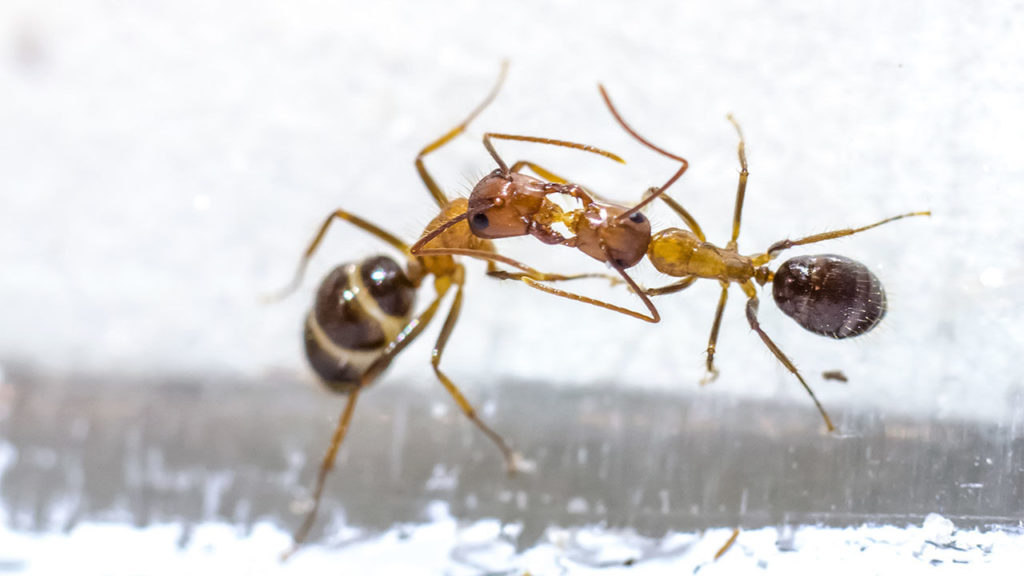An ant’s kiss may hide a sneaky form of communication
If you’ve ever watched ants, you’ve probably noticed their tendency to “kiss,” quickly pressing their mouths together in face-to-face encounters. That’s how they feed each other and their larvae. Now, scientists report that the insects are sharing much more than food. They are also communicating—talking via chemical cocktails designed to shape each other and the colonies they live in.
The finding suggests that saliva exchange could play yet-undiscovered roles in many other animals, from birds to humans, says Adria LeBoeuf, an evolutionary biologist at the University of Lausanne in Switzerland, and the study’s lead author. “We’ve paid little attention to what besides direct nutrition is being transmitted” in ants or other species, adds Diana Wheeler, an evolutionary biologist at the University of Arizona in Tucson, who was not involved with the work.
Social insects—like ants, bees, and wasps—have long been known to pass food to one another through mouth-to-mouth exchange, a behavior known as trophallaxis. They store liquid food in “social stomachs,” or crops, from which they can regurgitate it later. It’s how nutrients are passed from foraging ants to nurse ants, and from nurses to the larvae in a colony. Other research has suggested that ants also use trophallaxis to spread the colony’s odor, helping them identify their own nest mates.
To see whether trophallaxis plays a role in ant communication, LeBoeuf and her colleagues collected the trophallactic fluid of Florida carpenter ants (Camponotus floridanus). Using a range of chemical and biological methods, the researchers discovered that this social fluid contains a diverse array of chemicals, including growth-, digestion-, and immune-related proteins; nest mate recognition cues; and a juvenile hormone, important for regulating ant reproduction, development, and behavior.
The discovery of the juvenile hormone was particularly unexpected. “[It’s] a big upset,” says LeBoeuf, explaining that previously scientists thought the hormone was simply present in the insect’s bloodstream. Instead, it appears that the adults are passing it “in a private communication” to the larvae. “It suggests they’re deciding what the larvae are going to be when they grow up.”
The scientists tested that idea experimentally. They gave groups of 25 to 30 worker ants five to 10 larvae to rear, providing the workers with food that was either supplemented with the hormone or a solvent. Larvae that received the hormone-laced food were twice as likely as the controls to mature into adults, and they grew into slightly larger minors than usual—these are the smaller of two worker castes. That means that nurse ants must be selectively feeding larvae the hormone, depending on what type of adult workers the colony needs, LeBoeuf says. In essence, the nurses are “deciding the long-term shape and fate of the colony.” Adds Wheeler, “It’s a way to integrate the colony,” to ensure it functions as a single entity.
The researchers also analyzed the socially exchanged fluid of three other species: two other ants and the honey bee. They found similar and additional proteins connected to growth, development, and maturation, they report today in eLife.
Scientists used to think the molecules in social insects’ regurgitated food were simply “byproducts,” says Ofer Feinerman, a biophysicist at the Weizmann Institute of Science in Rehovot, Israel, who was not involved in the study. The new work, he says, shows they instead play “an active role in regulating the colony’s behavior, population structure, and immune resistance.”
Ants, of course, aren’t the only animals exchanging body fluids over a social network. “Sperm, breast milk, the saliva in a kiss—there are so many social fluids that are so exciting and just waiting to be explored,” LeBoeuf says. “Up to now, these have been private, privileged forms of communication,” though she notes that semen is known to influence female physiology. Could these fluids affect the receivers in other unexpected ways, influencing their behaviors, relationships, and social standing? The ants’ answer is “Yes.”
*Correction, 30 November, 11:35 a.m.: This story erroneously stated that larvae fed the hormone-laced supplement grew into the large, major ants; it has been changed to reflect that they actually matured into larger, minor ants.

